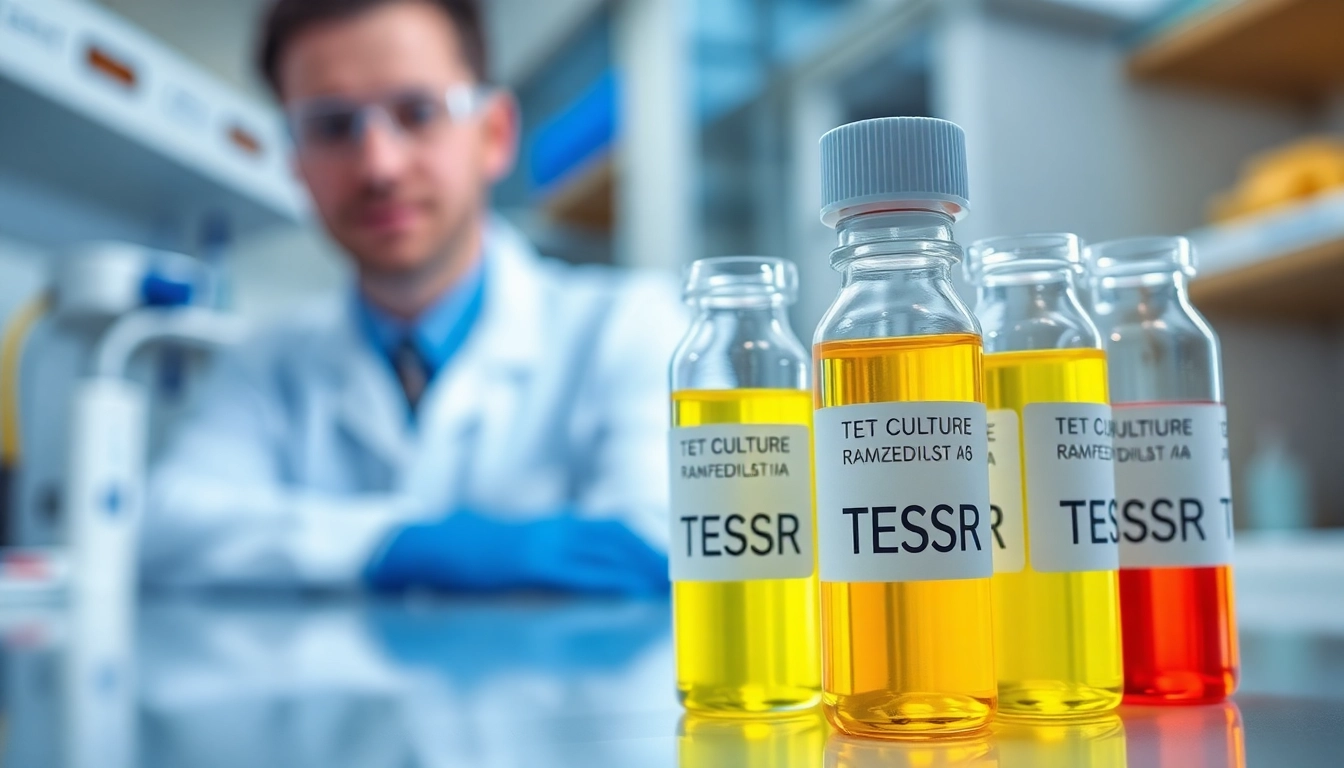Introduction to TeSR™ Feeder-Free Media
The advent of pluripotent stem cell (PSC) research has transformed our understanding of regenerative medicine and cell therapy. Central to this innovation is the development of sophisticated culture media that support the optimal growth and differentiation of these cells. Among such breakthroughs is the TeSR™ media family, which includes a variety of feeder-free media tailored for human embryonic stem (hES) cells and induced pluripotent stem (iPS) cells. This article delves deeply into the features, benefits, and applications of TeSR™ media, along with expert insights that underscore their significance in modern biological research.
What is TeSR™ Media?
TeSR™ media refers to a line of feeder-free culture media specifically designed for the maintenance, differentiation, and cryopreservation of human pluripotent stem cells (hPSCs). Developed based on pioneering research led by Dr. James Thomson and his team, these media are meticulously formulated to provide the essential nutrients and growth factors hPSCs require, enabling them to thrive in vitro without the need for animal-derived feeder layers.
Importance of Feeder-Free Systems
Feeder-free systems like TeSR™ media offer several advantages over traditional feeder-based cultures. They minimize the risk of contamination and variability, allow for easier scaling of cell cultures, and facilitate more reproducible experimentation. Furthermore, feeder-free cultures support better characterization of stem cells, which is crucial for both research and therapeutic applications.
Overview of Key Products in the TeSR™ Family
The TeSR™ family is extensive, featuring numerous products designed for different applications:
- mTeSR™ Plus: A maintenance medium optimized for hPSCs that enhances cell quality and stability.
- TeSR™-AOF: Animal origin-free media that provides assurances against contamination by animal-derived components.
- TeSR™-E8™: A simplified formulation focusing on essential nutrients for maintenance, reducing complexity while ensuring efficacy.
- ReproTeSR™: Specifically designed for the reprogramming of somatic cells into iPS cells.
- mFreSR™: A cryopreservation medium that enhances the viability and functionality of stored stem cells.
Understanding Human Pluripotent Stem Cells (hPSCs)
Characteristics of hPSCs
Human pluripotent stem cells are characterized by their ability to differentiate into any cell type in the human body, making them an invaluable resource in regenerative medicine. They exhibit two key properties: pluripotency, which refers to their ability to become any cell type, and self-renewal, allowing them to replicate indefinitely without losing their characteristic traits.
Applications of hPSCs in Research
The potential applications of hPSCs are vast and varied. They are used in drug development, disease modeling, and the creation of cell therapies for conditions such as diabetes, heart disease, and neurodegenerative disorders. Their unique properties allow researchers to study disease mechanisms in human cells and test the efficacy of new drugs in a controlled environment.
Challenges in hPSC Culture Maintenance
While hPSCs hold great promise, maintaining their quality and pluripotency in culture can be challenging. Factors such as media composition, the presence of contaminants, and the technique of passaging can significantly affect the cells’ behavior. The need for optimized culture conditions is where TeSR™ media plays a crucial role, providing a consistent, reliable environment for hPSC culture.
Benefits of Using teSR™ Maintenance Media
Advantages of Feeder-Free Culturing
Feeder-free culturing offers a range of benefits that address the pitfalls associated with feeder-dependent systems:
- Reduced Contamination Risk: The absence of feeder cells minimizes the chances of introducing pathogens or other contaminants.
- Improved Reproducibility: Uniformity across experiments is enhanced as variability introduced by feeder layers is eliminated.
- Scalability: Feeder-free systems facilitate the scaling-up of cultures for larger experiments or clinical applications.
Comparative Analysis of teSR™ Products
TeSR™ products stand out among other media due to their formulation based on extensive research. For instance, mTeSR™ Plus builds upon mTeSR™1, offering enhanced buffering capacity to prevent acidification and stabilize pH during cell maintenance. In contrast, TeSR™-E8™ focuses on reducing the protein content in the medium, which simplifies the maintenance protocol while retaining essential cellular functions.
cGMP Compliance and Quality Control
One of the distinguishing features of TeSR™ media is their compliance with current Good Manufacturing Practices (cGMP). This ensures that each product is manufactured under rigorous quality control conditions, which is crucial for clinical applications. The consistency and reliability of the media’s performance help researchers achieve reproducible results across experiments.
Media Formulations for Differentiation and Reprogramming
Key Formulations and Their Applications
Different TeSR™ products are tailored for specific applications in the stem cell research landscape:
- TeSR™-E6 and TeSR™-E5: Designed for differentiation into specific lineages, such as mesodermal and ectodermal cells.
- TeSR™-E7™: A specific formulation for the efficient reprogramming of fibroblasts into iPS cells.
- ReproRNA™-OKSGM: This medium is pivotal for optimizing reprogramming techniques, such as RNA-based methods.
Case Studies on Successful Differentiation
Numerous studies have successfully demonstrated the efficacy of TeSR™ media in differentiating hPSCs into specialized cell types. For example, researchers have used TeSR™-E6 to generate cardiomyocytes, achieving high purity and functionality, which is critical for cardiac regeneration applications. Similarly, TeSR™-E5 has been shown to produce neurons suitable for neurogenesis studies.
FAQs about Reprogramming Techniques
Reprogramming techniques are crucial for converting somatic cells into iPSCs. Researchers often have questions regarding the optimal use of TeSR™ media for this process. Common inquiries include:
- What are the best conditions for using ReproTeSR™? It is recommended to maintain low cell densities and perform frequent media changes to achieve optimal reprogramming efficiency.
- How do external factors impact reprogramming success? Factors such as the age of the donor cells, the method of transfection, and the choice of reprogramming factors significantly influence the overall success rate.
Expert Insights and Future Trends in Stem Cell Culture
Interviews with Leading Scientists
Experts in the field share valuable insights on the future of hPSC research. Dr. Joseph C. Wu emphasizes the importance of transition efficiency during hematopoietic differentiation, while Dr. Andrew Elefanty highlights the distinctions in methodologies between developing definitive endoderm from hPSCs. Each expert’s perspective contributes to a broader understanding of the challenges and possibilities in stem cell culture.
Emerging Technologies in Stem Cell Research
Emerging technologies are set to revolutionize stem cell culture. These include automated bioreactor systems for scaling up cell production, advanced imaging techniques for monitoring cell morphology in real-time, and synthetic biology approaches to engineer and manipulate stem cell fate. Integrating such technologies with established media like TeSR™ can pave the way for significant advancements in personalized medicine.
Practical Tips for Maximizing Experiments
Researchers utilizing TeSR™ media can optimize their experiments with the following strategies:
- Regular Monitoring: Implementing real-time cell monitoring can enable timely interventions and maintenance adjustments.
- Optimization Protocols: Tailoring media formulations and adjusting cell densities according to specific experiments can significantly impact results.
- Documentation and Sharing: Keeping detailed records of experimental settings and sharing findings within the research community can enhance collective knowledge and progress.
Conclusion
In summary, the TeSR™ family of feeder-free culture media represents a significant advancement in the field of pluripotent stem cell research. Their formulation, compliance with cGMP standards, and proven efficacy in supporting the maintenance, differentiation, and cryopreservation of hPSCs make them invaluable tools for researchers worldwide. As we move toward new frontiers in stem cell biology, using robust and reliable culture media will be critical in unlocking the full potential of stem cells for therapeutic applications.



















